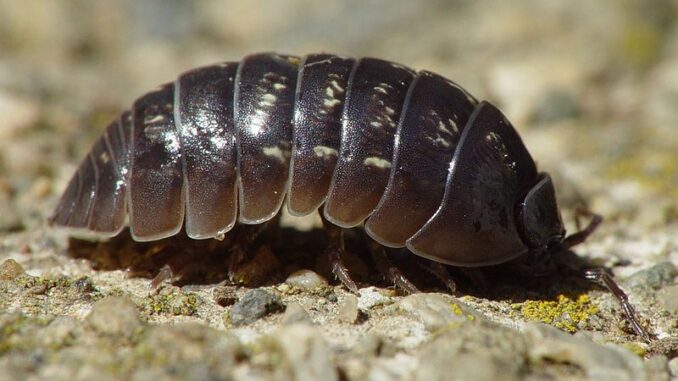
Anyone who’s spent time outdoors, especially in the garden, is familiar with the pill bug. When they feel threatened, they roll up in a ball like an armadillo, only just the size of a pill rather than the size of a cat. In colloquial terms, they’re also known as the armadillo bug, potato bug, common pill woodlouse, roly-poly (rollie pollies), slater, doodle bug, carpenter, or common pill-bug. Perfectly harmless (or nearly so) they do not carry any diseases, and they don’t bite or sting. They prefer to eat rotting vegetation, which makes them very desirable to have residing in your garden. However, if no decaying plant material is available, they’ll resort to munching on the roots of young plants: this is the one and only time when pill bugs are not harmless. Afficianados of the great indoors will be pleased to learn that pill bugs die pretty quickly if they come inside, as it’s too dry for them. They need a wet, humid environment to survive such as found under leaves and mulch.
Now for a few surprising factoids about these terrestrial isopods. First, they are not insects, they are crustaceans. Related to lobsters, crayfish, and shrimp, they adapted long ago to living on land. In fact, Armadillidium are the only crustaceans that widely made the transition from life in the sea to living off the land. They breathe through gills, yet ironically they will drown if submerged in water.
With something like 4,000 different species of Armadillidium, one of the most common is A. vulgare, pictured above. Born with six pairs of legs, fully grown Armadillidium have seven pairs and it’s no coincidence that they have segmented ‘armored’ sections similar to a lobster’s tail.
Their blood is blue when exposed to oxygen. (Recall that human blood is blue until exposed to oxygen, then it turns red). This is because Armadillidium blood contains hemocyanin (containing copper) instead of hemoglobin (containing iron).
Armadillidium love heavy metals, including arsenic, cadmium, copper, lead, and zinc, which they ingest and crystalize, making them useful creatures adept at soil decontamination.
Question Of The Night: Iron Man or Aquaman?
